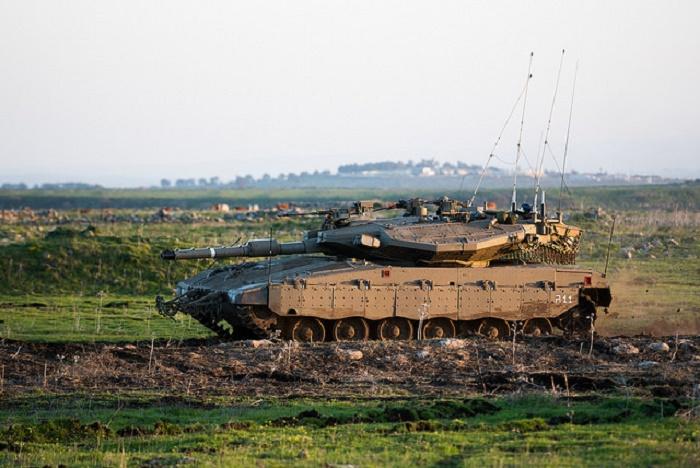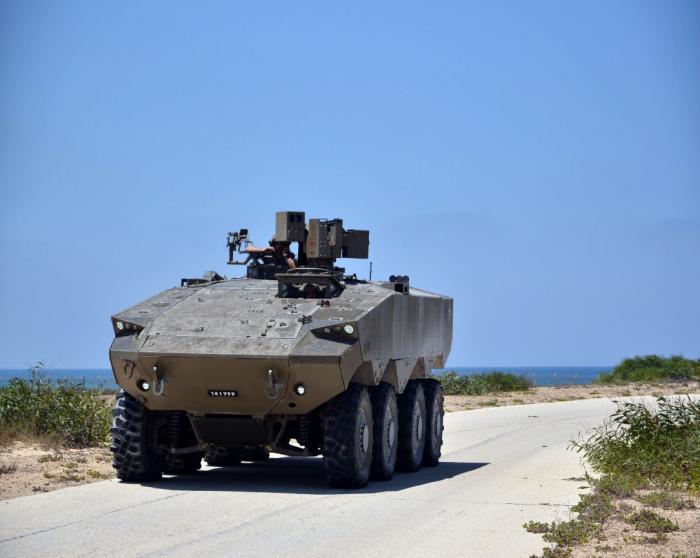Background
Amid a problematic period for the IDF Armored Corps, several highly important announcements were made. The Armored Corps has a popularity issue, and to be more exact - it is the least popular in the ground forces. In the last incident, 86 men who were conscripted to the armored corps, refused to be enlisted to the corps and demanded to be reassigned to other units, primarily infantry.
To repair this, the IDF came out in a few statements that will likely bring up its popularity. A very vaguely said one, but perhaps the most important of them all, is the development of a thorough upgrade for the Merkava 4, named Barak.
The Barak is said to be already in development, with a working prototype being ready within 3 years from now.
As a side note; Merkava 3 tanks are also slated to receive the Trophy APS of the upgraded variant, on which I will elaborate further in this post.
Stated features
1)More and larger touchscreens.
2)External cameras.
3)Upgraded Trophy system.
4)Better, BMS, observation and identification systems.
5)Sensor fusion and data fusion.
6)Unmanned Ground Vehicle operation.
What can we infer
1)Makes it practically a "smart" tank that brings it closer to what the youth that operates these tanks is familiar with. Every crew member's interface will be easier to handle.
2)External peripheral cameras existed on Merkava tanks for a little over a decade now. Clearly the mean something else, right? Right. The system at hand is the Elbit's IronVision which is based on Elbit's existing products - JHMCS 2 fighter pilot helmet designed for the F-35 warplane, and STA peripheral camera set that covers a hemispherical view (except the belly) around the tank.
So why cannot the IDF just settle for the STA and wants to go for the highly expensive helmet system? Because using the cameras with a joystick is time consuming in a rapidly changing environment, and it is tedious, which then forces tank crews to peek outside the tank and expose themselves.
Elbit's IronVision system
A usual setup for the IronVision is 2 helmets - one for the TC, and another for the driver.
3)The development of a Trophy 2 system has been announced in 2014 and is a cooperation between RAFAEL (developer of the Trophy 1), IMI (developer of Iron Fist), and IAI.
IMI will provide its Iron Fist interceptors, IAI will provide the radar, whereas RAFAEL will do the integration and development work.
Iron Fist and Trophy are two very different systems, with very different features that act as their selling points.

Iron Fist is a "grenade" launching system that applies a fragment-free directed spherical blast that would "cut" an ATGM or RPG mid-air, or will tilt an APFSDS shell to the point where it is no longer a threat. According to IMI's CEO, a simple 7° yaw would reduce the APFSDS's energy by up to 90%.
According to test footage, the yaw was actually far greater than 7°, and was nearing 45°.
At 3:00 a test against APFSDS is shown
Iron Fist provides a full protection suite that would defeat any form of existing fired anti-tank threat, but to do that it needs rather large munitions that cannot be reloaded in the current configuration.
Trophy, on the other hand, uses a much more unique method of firing an MEFP charge (Multiple Explosively Formed Penetrators) that sends sharp pellets flying towards the target. The charges are small and can be reloaded through an auto-loading system beneath it, however these small charges are unable to defeat APFSDS.
One more advantage of the Iron Fist is that it is more compact, and can be more easily applied to lighter platforms, for example the Eitan that will soon enter production. The Trophy is rather bulky in its current configuration when fitted to turreted IFVs.

Trophy HV on LAV III
4)The Merkava 4 is already equipped with a significant array of means to identify hostile elements. Starting with its basic gunner's and commander's sights with multi-channel feeds, to an interconnected BMS shared among the entire ground forces as well as the air force, to the Trophy which is able to pinpoint the location of an ATGM position immediately after firing.
It could very well mean that another element for search and identification will be used, and among the options is a BMS coupled with the IronVision that provide visual location of a pre-identified enemy, rather than a dot on a flat 2D display.
BMS are a great thing, but they're only as effective as the operator's ability to comprehend the data.

Even the best conventional BMS is not comfortable to operate
5)Tank Commanders (TC) are often overburdened with information in the heat of battle. Keeping up with constant reports of enemy movement, friendly movement, and ongoing fire exchanges is no easy task, and is highly prone to human error. For example in 2014 operation in Gaza, 5 soldiers were killed from friendly fire, and in an extreme case incident, a tank fired 4 HE shells on another friendly tank located several kilometers away. None was injured. The incident resulted from the TC's lack of understanding of where friendly units are positioned at the moment, and temporary lack of ability to identify the target as a friendly tank.
With the BMS, IronVision, and new communication technologies being implemented in the new Merkava 4 Barak, there is now a chance to integrate them into a single grid that will feed simplified data to the TC and substantially increase the combat capabilities of the tank on an individual level and battle group level.
6)The ability to receive feed from UAVs has existed for quite a long time, but UGVs are a completely different animal.
Although Israel does not yet make killer robots such as the Russian Uran-9, its industries have gained a world leader status in that field. The Guardium UGV has successfully been patrolling the Gaza border and around airfields, as well as in the volatile northern region, the Protector USV has been protecting Israel's ports, and a long line of UAVs have taken Israel Air Force's duty as the most numerous type of aircraft to be flown.
Israeli industries have showcased a very wide range of solutions based on unmanned vehicles; ranging from logistics, surveillance and convoy protection to decoys and possibly firing platforms.
Perhaps the most creative and cheapest one would be to use masses of repurposed M113 APCs converted for unmanned operation, as supply carriers, forward observation vehicles, decoys for IEDs, and a whole range of missions. They're available in thousands and the conversion is very cheap.
In military terms it's really nothing.
Israel is leading in robotic autonomy development, and so creating a fleet of unmanned vehicles based on M113 for a multitude of missions, would definitely be viable.
What it means
Touchscreens already exist on the Merkava, but improving the interface further and making everything more accessible, will shorten training time and will be another step towards IDF's plans to reduce overall service time, which many criticize as a wrong decision because training time will take up too much of that period.
The ability to see through the armor and into the environment and the higher level of data gathering from new sensors, its fusion into a streamlined and simplified data; will significantly improve the crew's situational awareness and thus their overall effectiveness in all existing combat scenarios.
The Trophy 2 system will likely incorporate an automatic loading system into the Iron Fist's launcher system, giving it a highly durable operation that would allow both defeating tank-fired APFSDS, and deal with high saturation fire from all sorts of threats.
And the ability to control drones would greatly aid the tanks, as a group, in any given scenario as well. It could be a convoy protection vehicle that detects mines and IEDs. It could be a forward observation light vehicle to provide early reconnaissance before the tanks arrive at the scene, thus give it more independence from infantry recon. And even simply cargo carrying vehicles.
Israel is constantly pursuing independence of its military units on every level. Starting with independence of every branch to conduct all forms of operations, to battalion size independence. Such overlap of capabilities ensures resilience of the combat units even when taking heavy losses.
It also gives the tank crew up to brigade level, more accessible information and thus more freedom to make actions.
All in all, the tank will become a lot easier to operate, and a lot more comfortable. Comfort and ease of operation are essential for the crew to fulfill the machine's potential as much as possible, and are key for increased performance both on the individual level, and on the theater.
The addition of Trophy APS to a wider range of vehicles is also a revolutionary action for the IDF. Just 2 years ago it was still a system that only those who enlist to the 401st brigade could get the opportunity to play around with. Now it's operational in 2 brigades and a host of other units are getting it - Namer, Eitan, and Merkava 3 have all joined in through a massive purchase of hundreds of APS systems from RAFAEL.
The IDF will thus not only have a sperheading brigade in its sleeve. It will have at least two divisions rolling with it.
Conclusion
The envisioned Merkava 4 Barak upgrade plan is no less than revolutionary. Even if it isn't a Merkava 5, as it is still very much based on the existing Merkava 4, its capability leap can be seen as greater than the leap between every generation of Merkava tanks.
Each generation of Merkava introduced a farther leap in capabilities than the predecessor, and the Mark 4 Barak seems to provide just the revolutionary capabilities that make it more of an improvement than the Mark 4 was over the Mark 3.
So while it isn't a Merkava 5, it could certainly qualify as such.
And why isn't it a Mark 5? Because the concept of the Merkava 4 pretty much makes it a very long lasting machine. Its modular armor construction ensures it can grow enough to protect against any future threat, as the older armor modules can be switched out with newer ones with bare minimal cost.
Its FCS architecture is also modular, and easily accepts new emerging technologies.
The engine bay allows for plenty of room for engine exchange.
And the gun mantlet was built in a way to accept even the much larger and heavier 140mm guns (in cooperation with Switzerland), so even if a certain firepower upgrade is needed, it won't be expensive.
The Merkava 4 is envisioned to stay in service for a very long time, and in parallel the Rakiya - the next generation of combat vehicles, will be developed and produced.
https://zuk-armor-il.blogspot.co.il/
@Penguin @500 @Natan @Archdemon @GBU-28 @F-15I @mike2000 is back @Blue Marlin @Mountain Jew @Beny Karachun @Adir-M @Ilay @theman111
























